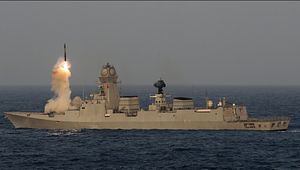The Indian Navy is in the middle of conducting a 30-day naval drill—the Navy’s largest military exercise ever—off India’s western coast, involving over 60 ships, five submarines, and 70 aircraft.
This year’s so-called Theater Readiness Operational Exercise (TROPEX) 2017 “is aimed at testing combat readiness of the combined fleets of the Indian Navy, and the assets of the Indian Air Force, Indian Army and the Indian Coast Guard” and “will also strengthen inter-operability and joint operations in a complex environment,” according to the Indian Ministry of Defense.
The exercise involves practicing various anti-submarine warfare scenarios with Indian diesel-electric attack submarines standing in for People’s Liberation Army Navy and Pakistan Navy submarines. According to local media reports, the INS Chakra, a Russian-made Akula-class nuclear-powered attack submarine, has been hunting “enemy” submarines 200 kilometers off Goa’s coast for the past few days.
The Indian Navy is also deploying its most advanced maritime patrol/anti-submarine warfare aircraft, the P-8I Neptune, to support the INS Chakra and track submarines during the exercise.
China has stepped up its submarine patrols in the Indian Ocean over the past two years as well as its surface naval presence.
Furthermore, China is slated to provide the Pakistan Navy with eight modified diesel-electric attack submarines by 2028. As I reported before, Beijing has also purportedly resumed construction of Type 039B Yuan-class diesel-electric attack submarines (SSK)–one of the quietest submarine classes in the Chinese Navy’s arsenal.
One of the major problems of the Indian Navy’s ‘silent service’ is that its submarine fleet is too noisy in comparison to more advanced Russian and Western forces, making them easier to detect and destroy in the event of war. However, the Pakistani and Chinese navies are supposedly suffering from the same problem. Chinese and Indian submarine technology is still considered to be at least a generation behind that of the U.S. and Japanese navies.
In addition, to the anti-submarine warfare scenarios, TROPEX 2017 also features surface warfare operations. According to media reports, the Indian Navy fired, for the first time ever, a Kh-35E anti-ship missile from a L-38 SD maritime reconnaissance aircraft against a target ship in the Arabian Sea, successfully scuttling the vessel.
Indian warships also fired various anti-ship missiles, including the BrahMos anti-ship cruise missile. Among the two most prominent surface warships participating in the drill is the INS Chennai, the third and final 7,500-ton Kolkata-class (Project 15A) guided-missile destroyer, as well as the aircraft carrier INS Vikramaditya, a modified Kiev-class carrier, in service with the Indian Navy since 2013.
TROPEX also featured a carrier defense scenario with MiG-29K fighters “fighting off” Indian Air Force Sukhoi-30s and Jaguar fighter jets armed with U.S.-made Harpoon anti-ship missiles. Additional drills are set to continue in the coming two weeks. According to the Indian Ministry of Defense, TROPEX is “conducted in various phases, both in harbor and at sea encompassing the various facets of war-fighting and combat operations.”
The exercise was last held in January 2015.

































